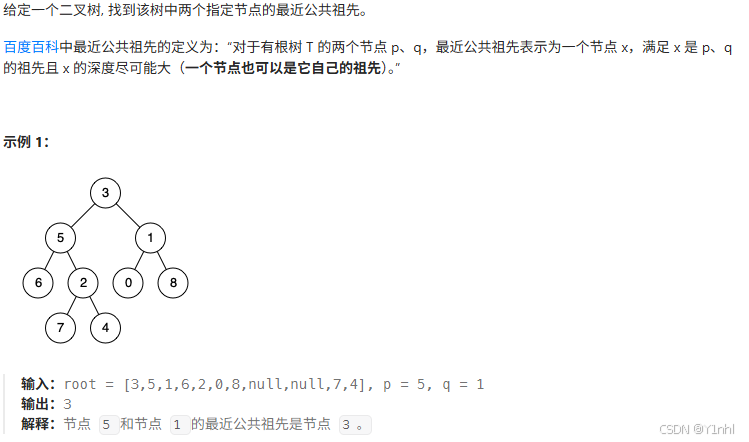搜广推校招面经一百零一
Triplet Loss 用于强化 anchor 和 positive 的距离比 anchor 和 negative 的距离更近,通常用于 embedding 学习。BPR Loss 是推荐召回中非常经典的pairwise ranking loss,目的是让正样本得分比负样本得分高。model.eval()# 设置为推理模式,使用moving统计量。model.train()# 设置为训练模式,使
小红书社区搜索算法二面
一、用了对比损失吧,手撕一下(项目中用了对比学习)
对比损失的核心思想是:
- 相似的样本对(label=1)距离应尽可能小
- 不相似的样本对(label=0)距离应超过 margin
数学公式:
给定两个样本的嵌入表示 x1, x2,标签 y ∈ {0,1},margin为m,损失函数定义如下:
L=y∗D2+(1−y)∗max(0,m−D)2L = y * D^2 + (1 - y) * max(0, m - D)^2L=y∗D2+(1−y)∗max(0,m−D)2
其中:
D = ||x1 - x2||表示两个样本的欧氏距离y = 1表示正样本对y = 0表示负样本对margin是希望负样本之间的最小距离
import torch
import torch.nn.functional as F
def contrastive_loss(x1, x2, y, margin=1.0):
# 欧氏距离
dist = F.pairwise_distance(x1, x2)
# 对比损失
loss = y * dist.pow(2) + (1 - y) * torch.clamp(margin - dist, min=0.0).pow(2)
return loss.mean()
```python
import torch
import torch.nn.functional as F
def contrastive_loss(x1, x2, label, margin=1.0):
"""
计算对比损失 (Contrastive Loss)
参数:
x1, x2: shape = [batch_size, embedding_dim],成对的样本嵌入向量
label: shape = [batch_size],1 表示正样本对,0 表示负样本对
margin: 对于负样本对,拉开的最小距离
返回:
标量 loss
"""
# 欧式距离
distances = F.pairwise_distance(x1, x2, keepdim=True) # shape: [batch_size, 1]
# Contrastive Loss 公式
loss_pos = label * torch.pow(distances, 2) # 正样本对损失
loss_neg = (1 - label) * torch.pow(torch.clamp(margin - distances, min=0.0), 2) # 负样本对损失
loss = 0.5 * (loss_pos + loss_neg)
return loss.mean()
二、召回的工作做得挺多,召回能用什么损失函数?
2.1. 二分类损失(Binary Classification Loss)
| 损失函数 | 说明 | 适用场景 |
|---|---|---|
| Binary Cross-Entropy | 最常用,优化点击/转化概率 | 用户-物品是否点击/召回 |
| Focal Loss | 关注难分类样本,缓解类别不平衡 | 类别极度不平衡的召回任务 |
2.2. 排序损失(Ranking Loss)
| 损失函数 | 说明 | 优点 | 框架支持 |
|---|---|---|---|
| Pairwise Ranking Loss(BPR) | 正负样本对得分比较 | 符合推荐目标 | PyTorch, TensorFlow |
| Triplet Loss | 三元组(anchor, positive, negative) | 简单有效的embedding学习 | PyTorch内置支持 |
| Contrastive Loss | 强化正负样本embedding距离差异 | 多用于embedding召回 | 需自定义实现 |
| Margin Ranking Loss | 控制正负样本得分差 ≥ margin | 通用且易优化 | PyTorch内置支持 |
| InfoNCE / NT-Xent Loss | 对比学习损失,用于无监督/自监督 | 提升embedding质量 | 推荐+对比学习结合场景 |
2.2.1. BPR Loss(Bayesian Personalized Ranking)
BPR Loss 是推荐召回中非常经典的pairwise ranking loss,目的是让正样本得分比负样本得分高。
LBPR=−log(σ(y^ui−y^uj)) \mathcal{L}_{\text{BPR}} = - \log(\sigma(\hat{y}_{ui} - \hat{y}_{uj})) LBPR=−log(σ(y^ui−y^uj))
- y^ui\hat{y}_{ui}y^ui:用户 uuu 对正样本物品 iii 的预测得分
- y^uj\hat{y}_{uj}y^uj:用户 uuu 对负样本物品 jjj 的预测得分
- σ(⋅)\sigma(\cdot)σ(⋅):Sigmoid 函数
import torch
def bpr_loss(pos_scores, neg_scores):
diff = pos_scores - neg_scores
loss = -torch.mean(torch.log(torch.sigmoid(diff) + 1e-8))
return loss
pos_scores = torch.tensor([3.0, 4.0, 5.0])
neg_scores = torch.tensor([1.0, 2.0, 1.0])
loss = bpr_loss(pos_scores, neg_scores)
print("BPR Loss:", loss.item())
2.2.2. Triplet Loss(三元组损失)
Triplet Loss 用于强化 anchor 和 positive 的距离比 anchor 和 negative 的距离更近,通常用于 embedding 学习。
LTriplet=max(0,d(a,p)−d(a,n)+margin) \mathcal{L}_{\text{Triplet}} = \max(0, d(a, p) - d(a, n) + \text{margin}) LTriplet=max(0,d(a,p)−d(a,n)+margin)
- aaa:anchor 向量(用户或查询)
- ppp:positive 向量(相关物品)
- nnn:negative 向量(无关物品)
- d(⋅,⋅)d(\cdot, \cdot)d(⋅,⋅):距离函数(如欧氏距离或余弦距离)
- margin\text{margin}margin:预定义的间隔常数,用于控制正负样本之间的最小差距
import torch
import torch.nn as nn
triplet_loss = nn.TripletMarginLoss(margin=1.0, p=2)
anchor = torch.randn(4, 128)
positive = torch.randn(4, 128)
negative = torch.randn(4, 128)
loss = triplet_loss(anchor, positive, negative)
print("Triplet Loss:", loss.item())
2.2.3. Margin Ranking Loss(边缘排序损失)
LRanking=max(0,−y⋅(x1−x2)+margin) \mathcal{L}_{\text{Ranking}} = \max(0, -y \cdot (x_1 - x_2) + \text{margin}) LRanking=max(0,−y⋅(x1−x2)+margin)
- x1x_1x1、x2x_2x2:两个样本的得分
- yyy:标签,取值为 1 表示 x1x_1x1 应大于 x2x_2x2,-1 表示相反
- margin\text{margin}margin:定义正负样本得分间的最小差距
- 当 y=1y = 1y=1,模型应让 x1>x2+marginx_1 > x_2 + \text{margin}x1>x2+margin
- 当 y=−1y = -1y=−1,模型应让 x1<x2−marginx_1 < x_2 - \text{margin}x1<x2−margin
如果当前排序已经满足 margin 要求,损失为 0;否则会进行惩罚。
import torch
import torch.nn as nn
margin_ranking_loss = nn.MarginRankingLoss(margin=1.0)
pos_scores = torch.tensor([3.0, 4.0, 5.0])
neg_scores = torch.tensor([1.0, 2.0, 1.0])
y = torch.ones(pos_scores.size()) # 标签,1表示pos > neg
loss = margin_ranking_loss(pos_scores, neg_scores, y)
print("Margin Ranking Loss:", loss.item())
三、BatchNorm 的训练与推理差异及可训练参数
3.1. 训练阶段(Training)
- 使用 当前 mini-batch 的均值和方差 来进行标准化:
μB=1m∑i=1mxi,σB2=1m∑i=1m(xi−μB)2 \mu_B = \frac{1}{m} \sum_{i=1}^{m} x_i,\quad \sigma_B^2 = \frac{1}{m} \sum_{i=1}^{m} (x_i - \mu_B)^2 μB=m1i=1∑mxi,σB2=m1i=1∑m(xi−μB)2 - 对每个特征进行标准化:
x^i=xi−μBσB2+ϵ \hat{x}_i = \frac{x_i - \mu_B}{\sqrt{\sigma_B^2 + \epsilon}} x^i=σB2+ϵxi−μB - 使用可学习的缩放因子和偏移参数:
yi=γx^i+β y_i = \gamma \hat{x}_i + \beta yi=γx^i+β - 更新全局的移动平均均值和方差(用于推理阶段):
- moving_mean
- moving_variance
3.2. 推理阶段(Inference / Evaluation)
- 使用训练过程中累积的 moving mean 和 moving variance:
x^i=xi−moving_meanmoving_variance+ϵ \hat{x}_i = \frac{x_i - \text{moving\_mean}}{\sqrt{\text{moving\_variance} + \epsilon}} x^i=moving_variance+ϵxi−moving_mean - 同样使用 γ 和 β 进行缩放和平移:
yi=γx^i+β y_i = \gamma \hat{x}_i + \beta yi=γx^i+β - 不再更新任何统计量。
3.3 可训练参数(Trainable Parameters)
BatchNorm 中的两个可训练参数是:
gamma (γ):缩放因子(scale)beta (β):偏移因子(shift)
这两个参数的作用是:- 允许模型恢复原始的特征表达能力(如果需要)。
- 在归一化之后仍保持模型表达能力。
3.4. 非可训练参数(缓冲区参数)
这些参数在训练过程中更新,但不进行反向传播:
- running_mean(即 moving_mean)
- running_var(即 moving_variance)
model.train() # 设置为训练模式,使用batch统计量
model.eval() # 设置为推理模式,使用moving统计量
四、236. 二叉树的最近公共祖先

class Solution:
def lowestCommonAncestor(self, root: 'TreeNode', p: 'TreeNode', q: 'TreeNode') -> 'TreeNode':
if not root or root == p or root == q:
return root
left = self.lowestCommonAncestor(root.left, p, q)
right = self.lowestCommonAncestor(root.right, p, q)
if not left:
return right
if not right:
return left
return root # 如果 left和right都有返回,返回这个root(公共节点)
五、4. 寻找两个正序数组的中位数

class Solution:
def findMedianSortedArrays(self, a: List[int], b: List[int]) -> float:
if len(a) > len(b):
a, b = b, a # 保证下面的 i 可以从 0 开始枚举
m, n = len(a), len(b)
a = [-inf] + a + [inf]
b = [-inf] + b + [inf]
# 枚举 nums1 有 i 个数在第一组
# 那么 nums2 有 j = (m + n + 1) // 2 - i 个数在第一组
i, j = 0, (m + n + 1) // 2
while True:
if a[i] <= b[j + 1] and a[i + 1] > b[j]: # 写 >= 也可以
max1 = max(a[i], b[j]) # 第一组的最大值
min2 = min(a[i + 1], b[j + 1]) # 第二组的最小值
return max1 if (m + n) % 2 else (max1 + min2) / 2
i += 1 # 继续枚举
j -= 1
更多推荐
 已为社区贡献29条内容
已为社区贡献29条内容









所有评论(0)